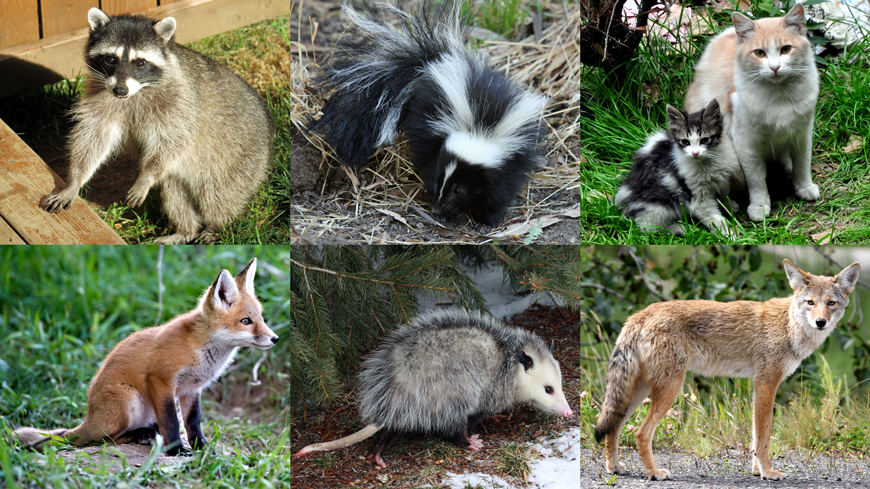Summary
Most flea infestations begin as eggs in shady, wind-protected areas of yards. After maturing, the adult fleas emerge from cocoons and jump onto pets. Infested wildlife, such as raccoons, traverse neighborhoods and deposit flea eggs into yards. Very few infestations begin from adult fleas transferring between animals.
Details
Dispersal of fleas is primarily passive. Although fleas can crawl or jump over short distances, transport from one habitat to another relies mainly on the movement of their primary hosts. Temporary hosts, especially predators of the primary host, also can transport adult fleas from site to site.
Flea Infestations Originate Outdoors
The majority of infestations originate outside. They develop from eggs to larvae to pupae, and eventually exit their cocoons as adults to jump on pets. This commonly occurs in the shaded areas of yards, where cats or dogs frequently rest. Sunny areas can’t support developing fleas.
Infested Wildlife Spread Fleas
Many small animals living in urban neighborhoods can carry cat fleas. Common hosts are opossums, raccoons, foxes, coyotes, skunks, and feral dogs and cats. A survey in Florida found fleas infesting 92.5% of feral cats. In urban Kansas, cat fleas were present on 61.5% of opossums and 21.6% of raccoons. Squirrels and birds aren’t hosts for cat fleas.
As infested wildlife travel through neighborhoods, they continuously drop flea eggs into yards. They’re like living saltshakers, as flea eggs fall anywhere the animals access.

Img 1 Common wildlife hosts — raccoon, skunk, feral cat, fox, opossum and coyote.
Urban Wildlife that Carry Cat Fleas
- Opossums
- Raccoons
- Stray cats & dogs
- Skunks
- Coyotes
- Foxes
- Rabbits
- Mongooses
- Hedgehogs
- Ferrets
- Weasels
- Martens
- Jackals
- Bobcats
- Panthers
- Koalas
- Marsh Deer
- Cattle
- Buffalo
- Horses
- Sheep
- Goats
- Poultry (rare)
- Small rodents (rare)
- Bats (rare)
- Lizards (rare)
- Armadillos (rare)
Outdoor Flea Hotspots
Both feral and domestic animals often seek shelter under covered areas. Common examples include structures like decks, porches, and crawlspaces. Hot spots also occur beneath bushes, shrubs, and other vegetation. Flea eggs and feces can quickly accumulate in these places. And fleas thrive in shady, protected habitats. Pets entering these zones can rapidly acquire fleas.
Domestic & Feral Animal Infestation Cycle
Pets can also spread fleas to feral animals. Wildlife enter the yard of an infested pet, and subsequently acquire fleas. The wild animal then further spreads the infestation around the neighborhood. There’s a continual feral–domestic infestation cycle wherever animal territories overlap.
Fleas Rarely Transfer Between Hosts
Dogs and cats seldom acquire adult fleas that jump off of another animal. Fleas rarely transfer hosts. Only 5% of fleas transfer between cage-separated hosts, and 7.5% transfer between animals which live together. Another study found similar results. Still, small numbers of fleas transferring between social animals can potentially start new infestations.
Adult cat fleas are permanent parasites, preferring to remain on their host. They’ll only abandon a dead or dying animal. As a result, new infestations can begin when a predatory animal attacks and kills its flea-infested prey.
It’s also a myth that fleas spread from being scratched off their host and into the environment. Removed fleas are often fatally damaged or quickly die of starvation.
Other Flea Sources
Pinpointing where a infestation took root can be difficult. External flea sources may include cars, other homes, as well as parks where many pets are walked. Fleas also occasionally hitchhike on people and get brought into homes to infest pets.
Examples: (1) A friend visits your home along with his infested dog. (2) Your sister agrees to watch your dog, and her home has fleas. (3) You take a road trip, pausing at a rest stop. Your dog lays down in the shade of a tree, where other flea-infested dogs have rested.
Dormant Pre-Emerged Adult Fleas
Within their cocoon, adult fleas can enter a quiescent state that lasts for up to 5 months. Fleas won’t emerge unless heat and physical pressure are detected. These cues indicate a nearby host. Once triggered, fleas emerge in 5 seconds.
Moving into a New Home
People moving into a new home or apartment sometimes encounter fleas, seemingly out of nowhere. This can happen if they don’t have pets. In all likelihood, the previous tenant’s pet had fleas. The fleas developed in the carpet and were in quiescence. When new occupants arrived, the fleas were triggered to wake and emerge.
Sending Infested Pets Away
Similarly, infested pets are sometimes sent away to a veterinary clinic or boarding kennel. During this time, pre-emerged adult fleas are accumulating in the home, waiting for a host before they emerge. When the animal returns home, the fleas exit their cocoon and re-infest the dog or cat.
Wildlife Entering Homes
Wildlife sometimes enter into homes through attics, basements, or crawl spaces. When the animals leave, they’ll have deposited eggs which develop into pre-emerged adults. Eventually the adult fleas emerge to bite people or pets in the home.
Causes for Reinfestation
Flea infestations often go undetected for 3-8 weeks. The population grows until it becomes noticeable. During this time, flea eggs have been continually deposited inside and outside the home. This biomass of immature fleas will be a source of emerging adults for 1-3 months. Pets are at risk of re-infestation from inside the home, and also outside in shaded areas.
Urban wildlife passing through yards can prevent infestations being completely eliminated. At any time, the problem can start all over again. Animals that live in an open environment, as opposed to indoor pets, are at a greater risk of re-infestation.




You must log in to post a comment. Log in now.